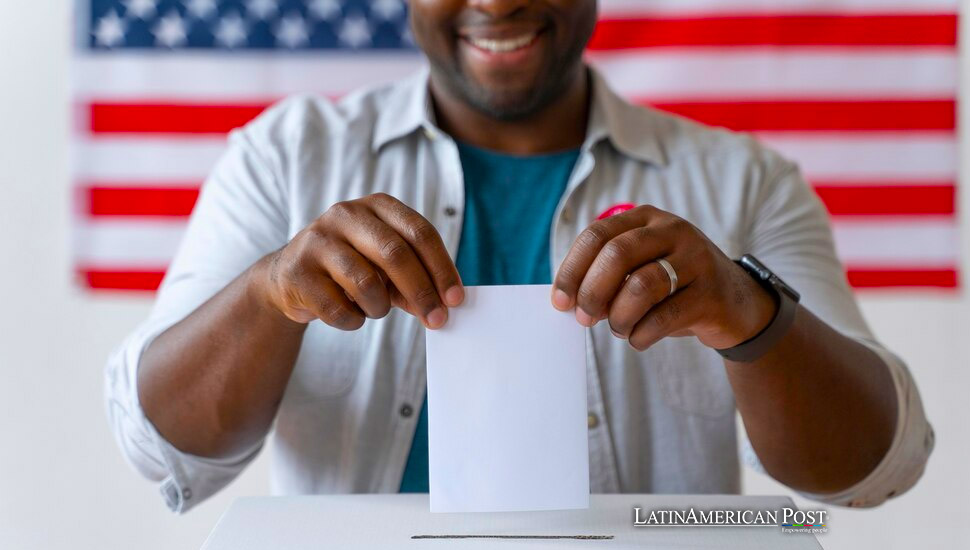Study Shows Systematic Underrepresentation of Latino and Black Voters in US Elections

An analysis of the 2020 election reveals that Latino and Black voters were systematically underrepresented, with significant racial disparities in voter turnout and ballot acceptance, particularly in key swing states that decided the election outcome.
In the aftermath of the 2020 U.S. presidential election, one of the most hotly contested in recent history, a new analysis has brought to light troubling findings about racial disparities in voter participation. The report, titled “Race and Representation in Battleground Counties,” highlights how Latino and Black voters were systematically underrepresented, particularly in the crucial swing states that played a pivotal role in determining the outcome of the election. The findings underscore the enduring challenges faced by communities of color in accessing and exercising their voting rights, challenges that are exacerbated in districts where these communities form a majority.
The report, conducted by researchers from the Union of Concerned Scientists, focused on electoral data from 11 counties across seven states: Arizona, Georgia, Michigan, North Carolina, Ohio, Pennsylvania, and Wisconsin. These states were not just battlegrounds in the 2020 election; they were decisive in securing the victory of President Joe Biden. The counties chosen for the analysis, including Maricopa County in Arizona, are emblematic of the demographic shifts and political battlegrounds that have come to define modern American elections.
The researchers found what they described as a “significant gap” in voter participation rates between Latino and Black voters compared to their Anglo-Saxon counterparts. This gap was evident even in districts where Latino and Black communities make up the majority of the population. In districts with a higher percentage of Anglo-Saxon residents, voter participation was notably higher, with an average turnout of 78%. In stark contrast, districts with majority Latino populations saw a turnout of just 54%, while those with majority Black populations had a turnout of 59%.
These disparities are not just numbers on a page; they reflect deep-rooted systemic issues that continue to marginalize communities of color in the electoral process. The lower turnout in these communities can be attributed to a range of factors, from voter suppression tactics to socioeconomic barriers that make it more difficult for these voters to engage in the electoral process. The report emphasizes that these disparities are not coincidental but are the result of a system that, whether intentionally or not, disenfranchises certain groups of voters.
Disparities in Ballot Acceptance
One of the most alarming findings of the report is the disparity in ballot acceptance rates between communities of color and their Anglo-Saxon counterparts. The researchers found that Latino and Black voters were significantly more likely to have their absentee or provisional ballots rejected. Specifically, the report states that 40% of absentee and provisional ballots from communities of color were rejected, compared to just 20% for Anglo-Saxon voters.
This discrepancy is particularly concerning given the importance of absentee and provisional ballots in the 2020 election. Due to the COVID-19 pandemic, a record number of voters opted to vote by mail or use provisional ballots, making the acceptance of these ballots critical to ensuring that every vote was counted. The higher rejection rates for ballots from communities of color suggest that these voters were disproportionately affected by policies or practices that led to the disqualification of their votes.
The report also notes that these disparities in ballot acceptance are not limited to the 2020 election. Historical data indicates that communities of color have long faced higher rejection rates for absentee and provisional ballots, a trend that has persisted despite efforts to make the voting process more inclusive. This finding underscores the need for reforms to ensure that all voters, regardless of race or ethnicity, have an equal opportunity to participate in the electoral process.
The Impact on Representation
The underrepresentation of Latino and Black voters in the 2020 election has far-reaching implications for their representation in government. As Liza Gordon-Rogers, an associate researcher at the Center for Science and Democracy, pointed out, “It’s surprising to see the real data from the elections and realize how much where you live determines whether your voice will be heard in the elections.”
When communities of color are underrepresented in the electoral process, their needs and interests are less likely to be reflected in government policies and decisions. This lack of representation can perpetuate cycles of inequality, as the voices of those most affected by social and economic disparities are marginalized in the very processes that could address those issues.
The report emphasizes that the disparities in voter participation and ballot acceptance are not just about the 2020 election; they have implications for future elections as well. With the 2024 election on the horizon, these findings highlight the urgent need to address the systemic barriers that prevent Latino and Black voters from fully participating in the democratic process.
The Myth of Widespread Illegal Voting
One of the most significant takeaways from the report is its refutation of the widespread conspiracy theories that have plagued recent elections, particularly the 2020 election. The researchers found no evidence to support claims of widespread illegal voting, a narrative that has been used to justify restrictive voting laws and policies that disproportionately affect communities of color.
The report argues that these conspiracy theories are “simply false” and that the real issue is not illegal voting but the systematic disenfranchisement of certain groups of voters. By focusing on the supposed threat of illegal voting, policymakers are diverting attention from the real issues that affect the integrity of the electoral process, namely the barriers that prevent marginalized communities from exercising their right to vote.
The researchers call for a shift in the conversation around election integrity, one that focuses on expanding access to the ballot rather than restricting it. They argue that ensuring that every eligible voter can participate in the electoral process is the best way to safeguard the integrity of elections and that addressing the disparities highlighted in the report is a critical step toward achieving that goal.
Recommendations for Future Elections
The report concludes with several recommendations for addressing the disparities in voter participation and ballot acceptance that were identified in the analysis. These recommendations are aimed at ensuring that future elections are more inclusive and that the voices of all voters are heard.
One of the key recommendations is the establishment of a baseline for detecting voting irregularities. By creating a standardized set of metrics for identifying and addressing issues in the voting process, election officials and advocacy groups can better understand who is being excluded from the electoral process and why. This baseline would also help to identify patterns of disenfranchisement, allowing for targeted interventions to address the specific needs of different communities.
The report also calls for increased investment in voter education and outreach, particularly in communities of color. By providing voters with the information and resources they need to navigate the voting process, election officials can help to reduce the barriers that prevent these voters from participating in elections. This includes efforts to ensure that voters understand their rights, how to cast a ballot, and what to do if they encounter problems at the polls.
In addition, the researchers recommend reforms to the absentee and provisional ballot process to reduce the disparities in rejection rates. This could include changes to the criteria used to evaluate these ballots, as well as efforts to make the process more transparent and accessible to voters. By ensuring that all ballots are treated equally, regardless of the voter’s race or ethnicity, election officials can help to restore confidence in the electoral process and ensure that every vote counts.
Finally, the report emphasizes the importance of continued research and analysis to monitor the impact of these recommendations and to identify new challenges as they arise. By staying vigilant and proactive, election officials, advocacy groups, and researchers can work together to create a more inclusive and equitable electoral process for all voters.
Moving Forward
The findings of the “Race and Representation in Battleground Counties” report are a stark reminder of the challenges that remain in the fight for voting rights in the United States. While the 2020 election was historic in many ways, it also exposed the deep-seated inequalities that continue to undermine the democratic process.
As the nation looks ahead to future elections, it is clear that more must be done to ensure that every voter, regardless of race or ethnicity, has an equal opportunity to participate in the electoral process. This will require a concerted effort from policymakers, election officials, and advocacy groups to address the systemic barriers that prevent communities of color from fully exercising their voting rights.
Also read: Biden’s Expanded Refugee Program Transforms Latin American Migration
By taking the steps outlined in the report, the United States can move closer to realizing the promise of a truly representative democracy, one in which every voice is heard and every vote is counted. The stakes are high, but the path forward is clear: to create a more just and equitable society, we must ensure that all citizens have an equal say in the decisions that shape their lives.





